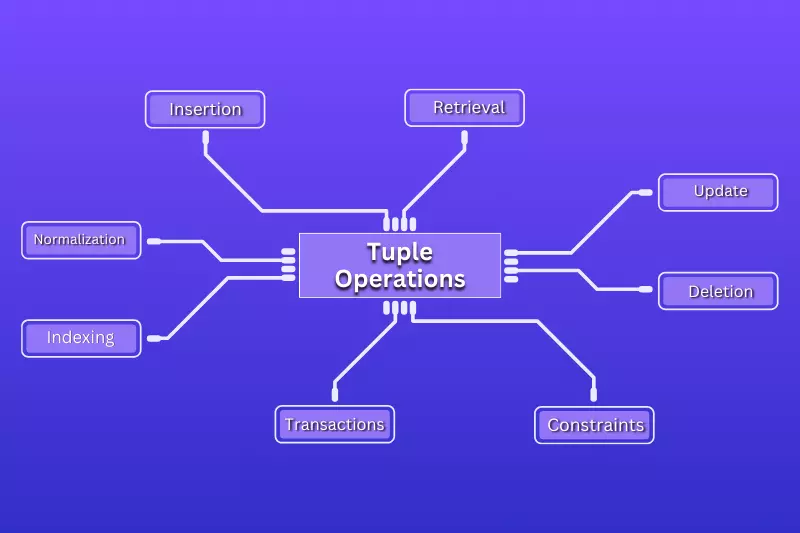What is a Tuple in DBMS? Types, Examples & How to Work
Table of Contents

If you’ve ever worked with a database, you’ve come across something called a tuple, even if you didn’t know it by that name. In simple terms, a tuple in a DBMS is just a single row in a table — nothing more complicated than that. Still, it plays a huge role in how relational databases operate.
This article explains what tuples are, what makes them important, and how they’re used, including some real-world examples and even a glance at Tuple Relational Calculus for those diving a bit deeper into theory.
*pravin-hub-rgb.github.io
What is Tuple in DBMS?
- In a relational database management system (DBMS), a tuple is basically a row of data in a table. Each table is made up of columns and rows. Here, columns are called attributes and rows are called tuples. So, this is the concept of tuple in DBMS. Every row holds a specific record, like one customer, one transaction, or one student.
- Think of a table called Students with columns like ID, Name, Age, and Course. A tuple in that table might look something like:
- (101, ‘Emma Brown’, 21, ‘Physics’)
- That’s a single record. It holds all the data related to one student.
Key Things to Know About Tuple in DBMS
Tuples aren’t just random pieces of data. They follow some specific rules that keep the database consistent and meaningful:
- Unique Rows: Usually, a primary key makes sure no two tuples are the same.
- Consistent Format: All tuples in a table must match the structure — if one has four fields, they all do.
- One Value per Field: Every column in a tuple should only contain a single value, not a list or group.
- Order Matters: The position of values in a tuple lines up with the column order.
Types of Tuple in DBMS You Might Encounter
Depending on what’s happening in your database, a tuple in the database can take on different forms:
- Stored Tuples: These are already sitting in your database table.
- Inserted Tuples: New rows are being added.
- Updated Tuples: Rows where some values have changed.
- Deleted Tuples: Records that have been removed.
- Derived Tuples: Temporary rows created by a query result.
Examples to Make Tuple in DBMS Clear
Here’s a sample Customers table:
| CustomerID | Name | City | |
|---|---|---|---|
| 301 | Alex Carter | alex.carter@email.com | Denver |
| 302 | Mia Wong | mia.wong@email.org | Seattle |
The first tuple in that table would be:
(301, ‘Alex Carter’, ‘alex.carter@email.com’, ‘Denver’)
Here’s another one — an Orders table:
| OrderID | CustomerID | Date | Amount |
|---|---|---|---|
| 501 | 301 | 2025-05-01 | 89.99 |
| 502 | 302 | 2025-05-03 | 45.50 |
One tuple in DBMS here would be:
(501, 301, ‘2025-05-01’, 89.99)
Each row like this is a tuple that holds one unit of data.
Tuple in DBMS with SQL
SQL is how we interact with tuples — to get them, change them, or add/remove them. Here are some examples:
— Fetch all customers in Seattle
SELECT * FROM Customers WHERE City = ‘Seattle’;
— Add a new customer
INSERT INTO Customers (CustomerID, Name, Email, City)
VALUES (303, ‘Liam Brooks’, ‘liam.brooks@email.com’, ‘Austin’);
— Update a customer’s city
UPDATE Customers
SET City = ‘Boston’
WHERE CustomerID = 301;
— Delete a customer
DELETE FROM Customers
WHERE CustomerID = 302;
All of these operations involve modifying or retrieving tuples from a table.

*fynd.academy
Tuple Relational Calculus in DBMS – A Bit More Advanced
Most people use SQL to get data from a database. But there’s a more theoretical way too: Tuple Relational Calculus, or TRC. It’s a logic-based, non-procedural query method, meaning it focuses on what you want, not how to get it.
The general TRC format looks like this:
{ t | condition on t }
Say you want the names of students older than 20:
{ t.Name | Student(t) ∧ t.Age > 20 }
Now, imagine you’ve got another table called Enrollment, and you want the names of students who are enrolled in ‘CS101’:
{ s.Name | Student(s) ∧ ∃ e (Enrollment(e) ∧ e.StudentID = s.StudentID ∧ e.CourseID = ‘CS101’) }
This tells the system: “Find all student names. Name such that there exists an enrollment e where the student ID matches and the course is CS101.”
TRC vs. DRC – What's the Difference?
Tuple Relational Calculus (TRC) works with whole tuples (rows), while Domain Relational Calculus (DRC) focuses on fields (individual values).
Here’s how a DRC version of our earlier query might look:
{ <n> | ∃ id, a, c (<id, n, a, c> ∈ Student ∧ a > 20) }
Both TRC and DRC are used in database theory. They’re similar in power — anything you can do in one, you can do in the other — but they differ in style.
Integrity of Tuple in DBMS
Keeping your database clean isn’t just about storing numbers and names in rows. You also need to ensure that all the information stored in the database makes sense.
where you should check database integrity. They’re the built-in rules that stop you from entering garbage data.
Now, each row or tuple in a database has to follow some ground rules. Let’s take a look at what those rules are and why they matter.
Data That Makes Sense
Imagine you’re filling out a form. Now it asks for your age. You type “banana” or maybe “-10.” A normal system should say, “Nope, try again.” That’s a domain rule that is doing its job. It says, “This field only accepts numbers between, say, 0 and 150.” So if someone tries anything weird, the system blocks it. It’s a small thing, but it saves you from chaos later.
IDs and Uniqueness (Key Stuff)
Here’s where things get a bit more technical.
A Primary Key is like a student roll number—no two people can have the same one, and you can’t leave it blank. It helps the system to differentiate one row from another.
A Foreign Key, on the other hand, connects two tables. For example, an “Orders” table needs to know which customer made each order. So, it uses the “CustomerID” from the “Customers” table. That way, every order has someone tied to it, and you can’t add an order without a matching customer.
Making Sure There's No Duplicate Info
Sometimes, a field needs to be unique, but it’s not the main identifier. Think about email addresses. Two people shouldn’t be able to sign up with the same one. That’s where uniqueness constraints step in. Unlike primary keys, they might allow empty fields, depending on how things are set up.
Custom Rules (Check Constraints)
Sometimes you need to get specific. Say your program only accepts students who are 16 or older. You can build that rule right into the system. If someone underage tries to join, the system simply won’t let it happen. These rules can be anything—just depends on your needs.
Mandatory Fields
And finally, there are fields that you must fill out. So, you can’t leave them empty. Think names, IDs, or anything else the system can’t work without. If it’s marked as NOT NULL, you have to put something in there. Otherwise, the database will cause an issue.
These rules might sound simple, but they’re why your data stays solid. Without them, things would be messed up. These can be missing IDs, duplicate emails, nonsense values, etc. Tuple constraints are like invisible referees keeping the game fair behind the scenes.
Database Normalization and Tuples
When you create a database, one of your main goals is to keep the data clean. Also, you should focus on repeating information unnecessarily. That’s where database normalisation comes in. It’s a process that organises your data to reduce duplication or redundancy. Also, it ensures everything stays accurate. The rows in your tables, known as tuples, change depending on how well this process is followed.
Normalisation breaks down the database design into different steps, called normal forms. These steps help prevent common problems like repeated data or errors when adding, deleting, or changing records. Let’s walk through these stages and see how they affect the tuples in your database.
First Normal Form (1NF)
The first rule is pretty simple. Here, every field in each row should hold only one value. Thus, no lists or multiple items are allowed in a single cell. If you have a field with several values, you usually need to split that into separate rows. Again, you can create a new related table to split those values. This way, every tuple stays clear and easy to handle.
Second Normal Form (2NF)
Once you have 1NF sorted out, 2NF starts. It says that every field that’s not part of the main key should depend on the whole key. So it’s not just a part of it. This is important if your key is made of more than one column. If a field only relies on a piece of that key, it belongs in a different table. This reduces repeating the same information across many rows.
Third Normal Form (3NF)
3NF makes sure each piece of data depends only on the primary key. If some data depends on another non-key field, you must separate it.
For example, a department name depends on a department ID. So what should you do? You need to move the department name to its table. This keeps the data clean. It also makes updates easier and reduces mistakes.
How Tuples Are Stored on Disk
Tuples in DBMS don’t just float around. They have to live somewhere—on disk. The way they’re saved affects how fast your database works. Different systems use different storage styles. Let’s look at the most common ones.
Heap Files
This one’s the easiest. New tuples go in wherever there’s space. There is no requirement for a specific order. It’s quick to add stuff, but slow if you’re trying to find something specific. You might have to dig through a lot to get what you want.
Sequential Files
Here, tuples are saved in order, usually by a key, such as an ID. To retrieve them faster, you have to run the searches in that order. This helps sort data faster.
Indexed Files
This is another robust location where tuples in DBMS get smarter. An index (kind of like the one at the back of a book) helps find data quickly. You don’t search everything—just jump to the right spot. B-trees and hash indexes are two types often used.
Hashed Files
This method uses a hash function. It turns a key (like a name or ID) into a number. That number tells where the tuple goes. If you know the key, this makes finding data super quick.
Clustered Files
Sometimes, you need data from different places at once. Clustered files keep related stuff close together. That way, when you look up one thing, the other is already nearby. It’s great for joining and answering related queries.
The method used affects speed greatly. Some are better for adding data than others for finding it quickly. Picking the right one depends on how the data is being used.
Smarter Ways to Work with Tuple
SQL can do more than SELECT or UPDATE. There are other tools, too, that help when things get complicated.
Window Functions
These are cool. They don’t mix all rows into one. Instead, they look at each row and what’s around it. You can use them for rankings or running totals. It’s great when you’re working with grouped data.
CTEs (Common Table Expressions)
CTEs help clean up messy queries. You write a short table right inside your query, which makes things easier to follow. This is super handy when the logic gets long.
Subqueries
This is just a query inside another one. It’s used to filter or get data based on other data. Some give back one value, others return full sets, and some even change depending on the row they’re in.
Set Operations
This lets you mix results.
- Use UNION to put results together.
- INTERSECT finds what’s in both.
- EXCEPT removes one set from another.
These help when you have a lot of tuple data to compare.
Gain Advanced Knowledge of DBMS through a Professional Course
Want to learn more advanced DBMS knowledge? Head over to the Online Master of Science (Data Science)—Symbiosis School for Online and Digital Learning (SSODL). The programs available through Jaro Education provide comprehensive guidance about statistics, the data science life cycle, and other related technologies. For instance, they include NoSQL databases, data warehousing, data management, data analysis using Python, data protection, etc.
Some of the major KPIs of this program are –
- 24/7 access to the learning management system
- Curriculum deployed by the top 10 Symbiosis Institutes of India
- Online assessment as per UGC guidelines
- Peer-to-peer doubt-clearing sessions
Wrapping It Up
Tuples in DBMS may not sound exciting, but they’re at the core of how data is stored in relational databases. Each tuple is a snapshot of a record — one customer, one sale, one order.
Understanding how tuples work helps you write better queries, design cleaner tables, and avoid mistakes. And if you’re diving deeper into database theory, learning Tuple Relational Calculus gives you insight into how relational databases can be expressed through logic, not just SQL.
So, next time you work with a table, remember that every row you see is a tuple, and it’s doing more work behind the scenes than you might think.
Frequently Asked Questions
Define a tuple in DBMS?
A single row in the table is called a tuple in a database. Imagine each row in a spreadsheet. That’s a tuple. Let’s say you’ve got a list of students. One row might show a student’s name, roll number, course, and a few other details. This row makes a single tuple. It’s just a way of grouping related info in one place.
What exactly is relational calculus in DBMS?
Relational calculus is more like telling the database what you want. So, you don’t need to give it any steps to follow. You just have to describe the result you need. Now the system will do the rest behind the scenes. It’s kind of like saying, “Show me all employees older than 30,” without worrying about the exact process the database uses to find that info. It becomes super handy when you care more about the outcome than the method. It’s more about describing the result than detailing the process. There are a couple of types—like tuple relational calculus and domain relational calculus—but the main idea stays the same: you say what you want, and the database finds it.
Is there a difference between relational algebra and relational calculus?
Yes, it is. Relational algebra is kind of like giving directions. First filter this, then join that, etc. You’re telling the system how to get the answer. With relational calculus, you skip all that. You just describe what you’re looking for and leave the “how” up to the database. It’s like the difference between saying “Follow this recipe” versus “I want a chocolate cake.” Both get you dessert, but only one tells you how to make it.







![CISA Salary: 2025 Complete Earnings [Freshers to Experienced]](https://jaro-website.s3.ap-south-1.amazonaws.com/2025/10/CISA-Salary-2025-Complete-Earnings-Freshers-to-Experienced-1024x576.webp)








